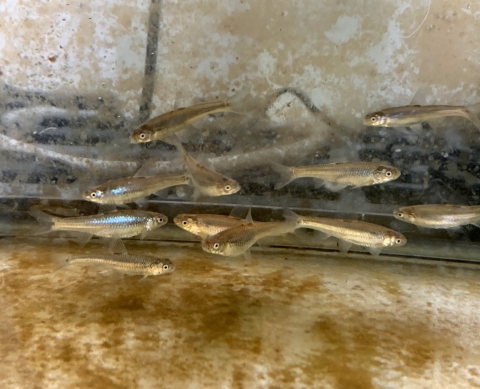When I tell people that I’m a fish biologist for the U.S. Fish and Wildlife Service, they immediately get a vision of me standing in a beautiful river casting a fly rod or on the front of a boat on a lake easily pulling up fish for our work. While I admit that I’ve had days like this, our work conserving American’s aquatic resources can often be demanding given the conservation challenges facing our natural environments. One of the best examples of successfully navigating conservation challenges is within the Service’s National Fish Hatchery System and the important role hatchery managers play in fish conservation. Sure, you say, taking care of fish doesn’t sound hard!! Let me try and convince you otherwise. Here are some of the challenges that National Fish Hatchery System, managers face each day.
There are big projects that Hatchery Manager Ralph Simmons and his team are excited about when they arrive for work at Tishomingo National Fish Hatchery in Oklahoma. The definition of “big” for the team, is how to safely handle and spawnthe 100-pound alligator gar they have at the hatchery. Alligator gar are the armor-covered warriors of the fish world, covered with bony scales (think enamel on your teeth kind of bony) and armed with a mouth of pointed, sharp teeth that perfect their ambush predator role in large river ecosystems.
One of the oldest and largest species in the freshwater fish world, alligator gar used to be common in the Southern United States in reservoirs and lakes and in the backwaters of lowland rivers along the Gulf Coast of Texas and into northern Mexico. Habitat loss and unregulated harvest has contributed to a significant reduction in their historic range. This makes what Ralph’s team must do even more important. Yet, alligator gar is a perfect example of how a species can evolve to be more successful in certain environments. Alligator gar have a modified swim bladder which acts like a rudimentary lung that allows them to gulp air from the surface of the water when needed; this gives them the ability to successfully survive and not suffocate when their habitat conditions become less than ideal.
So how does Ralph’s team handle such amazing creatures without losing their fingers? They have two federally approved drugs that help them with these tasks. The first one is a sedative that makes the alligator gar just a bit sleepy. However, just like a petulant child who won’t eat their vegetables at the dinner table and holds their breath in protest, gar will tightly shut their bony plates or operculum that covers their gills as soon as they sense the sedative in the water and rise to the surface to gulp air. So even with a sedative, making alligator gar sleepy is not as easy as it sounds. Once Ralph and his staff have gotten just enough sedative into the fish's system, the next step is a calculated injection of spawning hormone that goes under one of the bony scales on the gar’s back. The spawning hormone speeds up when the fish will produce eggs, so the timing is lined up and the team only needs to handle these fish twice. This means less stress for the fish and less stress for the staff. The result is lots of healthy gar that get stockedinto their historical range in the Midwest to help conserve and restore this species while providing angling opportunities.
Ralph’s second project is on the opposite end of the size spectrum but has “big” conservation gains. His team’s other responsibilities include conservation of Arkansas river shiners.
Federally threatened under the Endangered Species Act since 1998, Arkansas river shiners used to be found in western portions of the Arkansas River basin in Kansas, New Mexico, Oklahoma, Arkansas, and Texas. Shiners are found in main channels of wide, shallow, sandy bottomed rivers and larger streams of the Arkansas River basin, and prefer shallow channels where currents flow over clean fine sand. Since they seem to avoid calm waters and silted stream bottoms, habitat conditions are key to their survival and is likely the cause of their compromised survival in the wild. Getting these little minnows to spawn in captivity has been challenging for hatchery managers like Ralph. While managers can emulate many aspects of a fish’s natural environment, wild species such as the Arkansas river shiners often won’t predictably spawn in a hatchery setting. While the same sedative that is used for the warrior alligator gar is also used for the three inch or less Arkansas river shiners, a different hormone has been found to be more effective for the smaller fish. Ralph and his team use the smallest needle they can find (an insulin needle) to inject less than a drop of spawning hormone into each female shiner. Without the ability to use this spawning hormone and help the fish spawn in the protected hatchery environment, this fish would continue to decline in the wild. Conservation of this species is important because of its role in our ecosystem and to protect the abundant biodiversity within the Arkansas River system.
The hormones and sedatives that Ralph and his staff use are allowed through the Food and Drug Administration, or FDA, for use in aquatic animals. Having these substances available is the result of an unfathomable number of hours, funding, and the support of federal and state agencies plus the sponsors to get it approved for use by the FDA. One of the Federal agencies working on this task is the U.S. Fish and Wildlife Service and specifically the Aquatic Animal Drug Approval Partnership, AADAP. This program within the Service works with partners to get aquatic animal drugs approved by FDA and for use for conservation programs. Helping hatchery managers like Ralph get those “big” projects accomplished for fish conservation.





